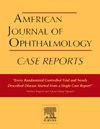Delayed-onset Moraxella nonliquefaciens endophthalmitis following intravitreal injection
Q3 Medicine
引用次数: 0
Abstract
Purpose
To report a case of Moraxella nonliquefaciens endophthalmitis presenting one month after intravitreal injection.
Observations
An 84-year-old man presented to the retina clinic with vision loss, pain, and redness in his right eye 28 days after a routine intravitreal injection of faricimab for exudative age-related macular degeneration. The patient had a remote history of cataract surgery, rhegmatogenous retinal detachment repair, and scleral buckle explant for exposure 3 years prior. The patient was found to have endophthalmitis, characterized by a hypopyon and dense vitritis. Broad-spectrum intravitreal antimicrobials and dexamethasone were administered, and a vitreous tap returned sterile. The patient achieved initial quiescence, but he had two recurrences of inflammation in this eye over the next 4.5 months. The patient ultimately underwent pars plana vitrectomy, vitreous biopsy, intraocular lens explant, capsulectomy and repeat intravitreal antimicrobial injections for definitive treatment. Broad-range PCR testing detected Moraxella nonliquefaciens. Inflammation resolved after surgery without further recurrence in the subsequent 7-month post-operative period.
Conclusions and importance
Moraxella species have been implicated in cases of endophthalmitis associated with glaucoma filtering surgery and trauma, but this report details a delayed-onset Moraxella nonliquefaciens-associated endophthalmitis after intravitreal injection.
玻璃体内注射后的迟发性非液化莫拉菌眼内炎
目的报告1例非液化莫拉菌眼内炎在玻璃体内注射后1个月出现的病例。一名84岁男性患者在常规玻璃体内注射法利西单抗治疗渗出性老年性黄斑变性28天后,因右眼视力下降、疼痛和发红而就诊于视网膜诊所。患者既往有白内障手术、孔源性视网膜脱离修复术及3年前巩膜扣外植体暴露史。患者被发现有眼内炎,其特征是低视和密集的玻璃体炎。给予广谱玻璃体内抗菌剂和地塞米松,玻璃体水龙头无菌。患者最初获得了平静,但在接下来的4.5个月里,他的这只眼睛有两次炎症复发。患者最终接受了玻璃体切除、玻璃体活检、人工晶状体植入术、荚膜切除术和反复玻璃体内抗菌药物注射。广谱PCR检测检测出非液化莫拉菌。术后炎症消退,术后7个月无复发。结论和重要性莫拉菌种类与青光眼滤过手术和创伤相关的眼内炎病例有关,但本报告详细介绍了玻璃体内注射后迟发性非液化莫拉菌相关的眼内炎。
本文章由计算机程序翻译,如有差异,请以英文原文为准。
求助全文
约1分钟内获得全文
求助全文
来源期刊

American Journal of Ophthalmology Case Reports
Medicine-Ophthalmology
CiteScore
2.40
自引率
0.00%
发文量
513
审稿时长
16 weeks
期刊介绍:
The American Journal of Ophthalmology Case Reports is a peer-reviewed, scientific publication that welcomes the submission of original, previously unpublished case report manuscripts directed to ophthalmologists and visual science specialists. The cases shall be challenging and stimulating but shall also be presented in an educational format to engage the readers as if they are working alongside with the caring clinician scientists to manage the patients. Submissions shall be clear, concise, and well-documented reports. Brief reports and case series submissions on specific themes are also very welcome.
 求助内容:
求助内容: 应助结果提醒方式:
应助结果提醒方式:


